Dicotyledons or in short dicots are a group of flowering plants having two cotyledons or embryonic leaves in their seeds. There are more than 200,000 different plant species found in this group. Here we are going to discuss examples of dicot in brief.
Among more than 20,000 plant species of dicotyledon plants, here we mention some most common examples of dicot-
Dicot plant examples
Let’s have a closer look at the examples of dicot.
Almond
Almond or Prunus amygdalus is a deciduous tree species belongs to the family Rosaceae, typically dicot in nature. It is a large tree native to southwestern Asian countries like Iran, cultivated widely. The almond tree bears pinkish-white flowers in early spring. After 7-8 months of flowering the fruits of almonds mature. The fruit of almond is typically a drupe having exocarp and endocarp. The almond seed is highly nutritious and gives several health benefits.

Almond tree from Pixabay.com
Peanut
Peanut is also one of the most common examples of dicot. The peanut plant is a herbaceous plant belonging to the legume family Fabaceae or Legumeceae. The plant has opposite pinnate leaves with 4 leaflets. The leaves show Nyctinasty or sleep movement at night. The peanut fruits show geocarpy means developed under the soil. After fertilization the gynopore develops into peg. It is a thread-like structure, and bears the fruit of peanuts under the soil.
Olive
Olive is one of the most common examples of dicot. Olive or Olea europaea is a short tree or shrub belonging to the family Oleaceae, native to the European region. The tree bears small, white flowers and fruits which are actually drupes.
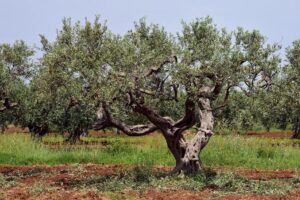
Olive tree from Pixabay.com
Lettuce
Lettuce or Lactuca sativa is a herbaceous dicot plant belonging to the family Asteraceae. The plant has leaves with a colourful spectrum in it. The species lives up to 65-130 days from harvesting. The plant has two types of root system, primary taproot system with another secondary root system. The fruit contains one dicot seed in it. Because of its high nutrition value lettuce production increases commercially.
Oak
Oak or Quercus is a monoecious tree typically belonging to the beech family Fagaceae. It is one of the most common examples of dicot. There are about 500 different species found under the genus Quercus. In the season of spring the tree produces both male and female flowers and bear fruits. The fruit of an oak tree is typically a nut, called acorn, containing one to three seeds each. The oak tree plays an important role in maintaining an ecology, thus it is an important keystone species also.
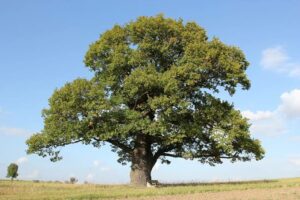
Oak tree from Pixabay.com
Maple
Maple or Acer is a deciduous dicot tree, belonging to the family Sapindaceae. There are about 132 different species found under the genus. Maples are native to the Asian regions. The tree is mostly known for its leaf colour during the sedding autumn session. The tree produces colourful flowers and bear fruits. The maple tree fruit is a special kind of fruit called samaras, a dry fruit in which flattened fibrous wing tissues develop. The seeds in it are enclosed in nutlets.
Beech
Beech or fagus is a deciduous monoecious tree, one of the most common examples of dicot. It typically belongs to the family Fagaceae. The plant grows mostly in temperate climatic regions like Europe, Asia, North America,etc. The plant bears both male and female flowers in it. The fruit of a beech tree is typically a nut, or covered by a capsule.

Beech tree from Pixabay.com
Apple
Apple tree or Malus domestica is a deciduous tree belonging to the family Rosaceae. The tree produces pinkish-white flowers in the season of spring. The fruit matures in the autumn or late summer. The apple fruit is protected by an epicuticular wax layer. The exocarp is generally pale white in colour and the skin of ripe apple is red, yellow or green in colour.
Mango
Mango or Mangifera indica is a large angersperm tree belongs to the family Anacardiaceae. There are more than 500 mango variants found in India. The tree produces reddish-yellow both male and female flowers in the season of spring. At the summer the tree bears egg- shaped dicot mango fruits. The mango fruit is the national fruit of India.
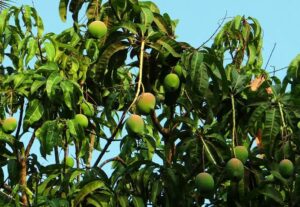
Mango tree from Pixabay.com
Blackberry
The blackberry is a perennial plant typically belonging to the rose family Rosaceae. In the late spring season the plant produces flowers on the tip of the recemes. The flowers have five colourful mostly pinkish-white petals each. There are more than 375 species of blackberry found under the genus Rubus.
Guava
Guava or Psidium guajava is a small tree typically belonging to the family Myrtaceae. The plant produces fruits. It is a native to Mexico, Central America and northern South American regions. Guava trees are also one of the common examples of dicot.
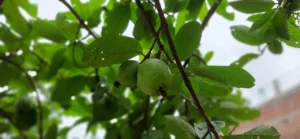
Guava plant from Pixabay.com
Papaya
Papaya is a dioecious plant species typically belonging to the family Caricaceae. There are more than 22 species found under the genus Carica. Both male and female flowers grow in the leaf axis of the plant. The plant bears berry-like fruits containing numerous dicot black seeds in it.
Jasmine
Jasmine is a deciduous shrub belonging to the olive family Oleaceae. It is mostly found in temperate climatic regions. More than 200 different species are found under the genus Jasminum. The plant bears white or yellow coloured flowers in the season of autumn. The Jasmine plant is also one of the most common examples of dicot. The plant is usually diploid in nature, containing 13 pairs of chromosomes.
Sunflower
Sunflower or Helianthus is an annual perennial angersperm plant species belonging to the family Asteraceae. There are more than 70 differeny species found under the genus. The plant bears the inflorescence or a terminal capitula. It has yellow ray florets and a brown disc floret. The Helianthus annuus is the most common species among all, widely cultivated worldwide.
Daisy
Daisy or Bellis perennis is a herbaceous plant belonging to the sunflower family Asteraceae. There are more than 30 species found under the genus Bellis. It is mostly found in the temperate climate, native to the European regions. The flower contains white ray florets and a yellow disc floret in it. The capitulum is surrounded by two rows of green bract. It is also one of the most common examples of dicot.

Daisy from Pixabay.com
Dandelion
Dandelion or Taraxacum is one of the most common examples of dicot. It is a herbaceous perennial plant belonging to the sunflower family Asteraceae. The plant grows mostly in temperate climatic regions. There are two most common dandelion species are Taraxacum officinale and Taraxacum erythrospermum. The plant bears white, yellow or orange flowers, consisting of several ray florets in it.
Rose
The rose plant is one of the common examples of dicot. It is a perennial predominantly deciduous plant belonging to the family Rosaceae. There are more than 300 species found under the genus Rosa. During the flowering season the plant produces colourful flowers. According to the species from red to pink, yellow, different coloured flowers are produced. The flowers usually have five petals and beneath the petals five sepals each. The plant bears berry-like fruits rose hips.

Rose plant from Pixabay.com
Hibiscus
China rose or Hibiscus is an annual perennial shrub typically belonging to the mallow family Malvaceae. Among hundreds of other species Hibiscus rosa sinensis is mostly cultivated worldwide. The plant bears flowers during the season of summer and autumn, typically red in colour. Apart from the red one, there are also white, orange, pink, peach, yellow and combination coloured flowers are also produced according to the species variety.
Cabbage
The cabbage or Brassica oleracea is also one of the most common examples of dicot. It is a biennial annual plant closely related to broccoli and cauliflowers, belonging to the family Brassicaceae. The plant produces yellow or white coloured flowers having four petals and four sepals each. The plant has a silique type of fruit which opens at the time of maturation via splitting process and releases the seeds.
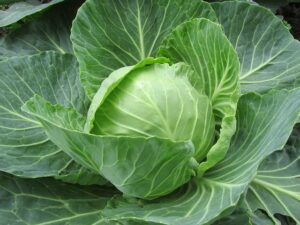
Cabbage plant from Pixabay.com
Peas
Pea or Pisum sativum is an annual herbaceous plant, one of the most common examples of dicot. It belongs to the family Fabaceae. The plant grows at the cooler seasons preferably at the temperature from 13 to 18 °C. The plant produces seed-pods, which contain several peas in it. The pea is generally green or golden yellow in colour. Self pollination occurs in this plant. The plant matures after 60 days of planting.
Cauliflower
Cauliflower or Brassica oleracea is an annual dicot plant typically belongs to the family Brassicaceae. The cauliflower is closely related to broccoli and cabbage. The name is also derived from the Italian word cavolfiore which means cabbage flower. The inflorescence of cauliflower made up of white meristems. Calliphora vomitoria blowflies are common pollinators of cauliflower.
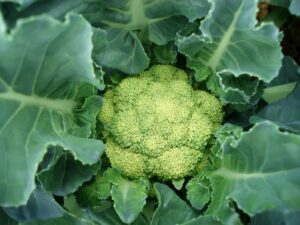
Cauliflower plant from Pixabay.com
Peach
Peach or Prunus persica is a deciduous tree, belonging to the rose family Rosaceae. It is one of the most common examples of dicot. The plant produces pinkish-white solitary or paired flowers in the early spring time. The fruit of the plant is reddish yellow or white in colour. The fruit is very juicy and the fresh is very delicate. The peaches are native to China and widely cultivated there.
Tomato
Tomato or Solanum lycopersicum is a vine, decumbent dicot plant typically belonging to the family Solanaceae. The tomato plants typically grow in temperate climatic regions. The tomato plant produces yellow coloured flowers on the apical meristem. After fertilization, the plant bears a berry-like fruit in it, which comprises the pericarp wall in it.
Brinjal
Brinjal or Solanum melongena is a perennial plant typically belonging to the family Solanaceae. It is one of the most common examples of dicot. The plant bears white and purple coloured flowers. The brinjal is a berry-like fruit, covered with nicotinoid alkaloids. It contains numerous dicot seeds in it. The plant is mostly cultivated in India and China. The brinjal is also known as eggplant.
Watermelon
Watermelon or Citrullus lanatus is an annual herbaceous plant belonging to the family Cucurbitaceae. It is a monoecious plant in which white or yellow coloured both male and female flowers are produced. After fertilization the plant bears big berry-like fruit called pepo. The fruit has thick green colored striped exocarp and red or orange coloured fleshy mesocarp and endocarp region in it. The fruit contains several dicot seeds in it.
As a whole, dicot plants are one of the most important plant groups that play a significant role in maintaining plant diversity. Here we discuss Some most common examples of dicot. We discuss their habitats, characteristics, etc. Hope the article on dicot plants will be helpful to you.
Also Read:
- Do plants absorb light
- Do eukaryotes have plasmids
- Dna transcription enzyme
- Cytoplasm and protoplasm
- Staphylococcus bacteria examples
- Are proteins traits 2
- Hypogynous flower example
- Facilitated diffusion example
- Functions of mitochondria
- Is cell membrane an organelle

Hello, I am Piyali Das, pursuing my Post Graduation in Zoology from Calcutta University. I am very passionate on Academic Article writing. My aim is to explain complex things in simple way through my writings for the readers.